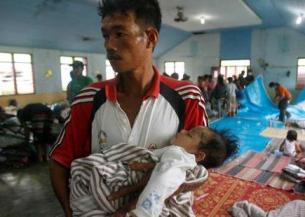 JAKARTA, 26 November 2010 (IRIN) – One month after a deadly tsunami struck Indonesia’s southern Mentawai islands, shelter for the more than 11,000 people affected remains a critical challenge, aid workers and officials say.
JAKARTA, 26 November 2010 (IRIN) – One month after a deadly tsunami struck Indonesia’s southern Mentawai islands, shelter for the more than 11,000 people affected remains a critical challenge, aid workers and officials say.
“The most urgent need for people affected by the tsunami is housing and [restoring] their livelihoods,” Andi Hanindito, head of emergency response with the Ministry of Social Affairs, told IRIN.
On 25 October, the islands were struck by a 3m-high tsunami triggered by a 7.7 magnitude earthquake off the coast of western Sumatra, which left 509 people dead, 21 missing, destroyed 550 houses and damaged another 200, the country’s National Disaster Management Agency reported.
One month on, more than 11,400 people remain displaced and are living in tents in the North Pagai, South Pagai, South Sipora and Sikakap districts.
Although the post-tsunami emergency phase officially ended on 22 November, the government is planning to build more than 1,000 temporary and 1,600 permanent houses for survivors (217 in North Pagai, 785 in South Pagai, 613 in South Sipora, and 16 in Sikakap), officials said.
With funding from national and provincial budgets as well as donors, the government is spending an estimated US$40 million on reconstruction, rehabilitation and relocation (expected to be completed by 2012), not only to help those in immediate need, but also to prepare the communities for the next disaster.
“The money will be spent not only on housing but also on infrastructure such as water, sanitation, communication networks and health, and on reviving livelihoods, including farming and fishing,” said Indroyono Soesilo, secretary for the People’s Welfare Ministry. The government is also relocating people who were not directly affected by the tsunami, but now want to move to higher ground for fear of the next disaster.
Temporary plans under fire
In the meantime, the displaced populations will be kept in temporary houses to be built by the Indonesian Red Cross (Palang Merah) from wood, with corrugated zinc roofs and wooden floors, said Ade Edward, head of the West Sumatra Disaster Management Agency.
But not everyone is pleased with the plans. Yayasan Citra Mandiri, a Bogor-based child rights NGO, has criticized proposals to move survivors away from their villages.
“The government is making a big mistake. The temporary houses will be built in the middle of woods, far away from people’s sources of livelihood. Their food security will be threatened if they all move,” said Frans Siahaan, the group’s deputy director.
“Some residents have expressed opposition to the move and said they would instead build their own homes because they don’t want to abandon their crops,” Siahaan said.
In order to provide economic support for those who have lost their livelihoods, the Social Affairs Ministry plans to establish local cooperative networks, and give survivors money for fishing and farming equipment, or help them start a business, Hanindito said. The amount, still being calculated, would likely be released next year.
Additional challenges
Poor communication remains an obstacle to the smooth distribution of aid supplies, said Dendi Pratama, programme director for Mentawai Relief, an aid group set up by West Sumatra university students, which has donated about $3,000, clothes and toys to the tsunami victims.
“Access to communication is important because there are often discrepancies between what is distributed and what the people need,” said Pratama, who has been in Mentawai since last month.
Adam Verdatama, an official at the National Disaster Management Agency, said survivors needed more staple food, blankets, sleeping mats and clean water.
As many volunteers have now left the region, there are concerns the government would not have the resources to distribute aid supplies.
“Food supplies will still be needed as long as the people have not started working in their fields,” Pratama said.


